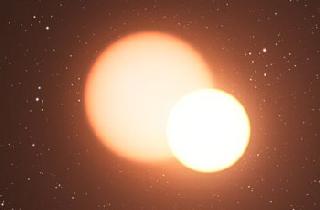
An artist's impression of the new-found double star system. An ESO photo
PARIS (BNS): The discovery of a double star system in the Large Magellanic Cloud with one of the stars being a pulsating ‘Cepheid variable’ has led astronomers to solve a long-standing mystery about the Cepheid star’s mass.
A Classical Cepheid Variable, also called a Cepheid, is an unstable star larger and much brighter than our Sun. Such stars expand and contract in a regular way, taking anything from a few days to months to complete the cycle. The time taken to brighten and grow fainter again is longer for stars that are more luminous and shorter for the dimmer ones.
Thus, the Cepheid stars provide a great means to measure the distances to nearby galaxies and from there to map out the scale of the whole Universe.
Despite their importance, astronomers have not fully understood such star systems to date. Predictions about the Cepheid stars’ mass have been derived by two theories – theory of pulsating stars and the theory of evolution of stars.
However, these theories have given discrepant results. The estimated mass of the star calculated through the pulsating stars theory is around 20 to 30 per cent less than the mass derived by using the evolution of stars theory.
To resolve this mystery, astronomers needed to find a double star containing a Cepheid where the orbit happened to be seen edge-on from Earth. In these cases, known as ‘eclipsing binaries’, the brightness of the two stars dims as one star passes in front of the other, and again behind it.
In such pairs, astronomers can determine the masses of the stars to high accuracy.
The new-found double star system exactly offers what the astronomers searched for so long. It positions the two stars in a rare alignment of their orbits whereby they pass in front of each other.
Using European Southern Observatory’s HARPS spectrograph at the La Silla Observatory in Chile, along with other telescopes, the team of international astronomers has found an ‘eclipsing binaries’ system, which has helped in measuring the mass of a Cepheid “with an accuracy far greater than any earlier estimates.”
“This new result allows us to immediately see which of the two competing theories predicting the masses of Cepheids is correct,” Grzegorz Pietrzyński, who led the research, said.
The Cepheid variable star in the system is pulsating every 3.8 days. The other star is slightly bigger and cooler, and the two stars orbit each other in 310 days.
After carefully observing the brightness variations, and other aspects of the two stars, the researchers found that the mass of the Cepheid star was almost exactly accurate to the calculations done by the theory of stellar pulsation.
However, the larger mass predicted by stellar evolution theory was shown to be significantly in error.
Astronomers hope to find more such pairs of binary stars for further analysis of the method. They also believe that such binary systems will eventually help them pin down the distance to the Large Magellanic Cloud to 1%, which would mean an extremely important improvement of the cosmic distance scale.
The new findings appear in the journal Nature.
 Next Article
Next Article











The Indian Air Force, in its flight trials evaluation report submitted before the Defence Ministry l..
view articleAn insight into the Medium Multi-Role Combat Aircraft competition...
view articleSky enthusiasts can now spot the International Space Station (ISS) commanded by Indian-American astr..
view article